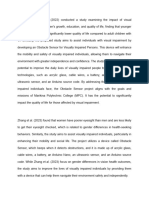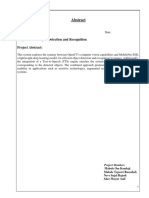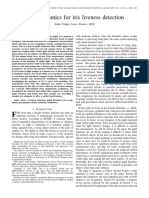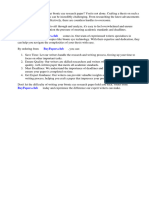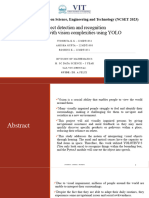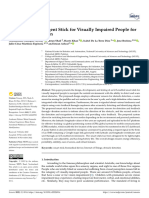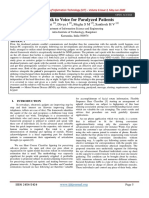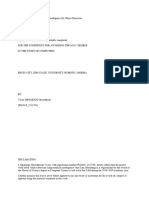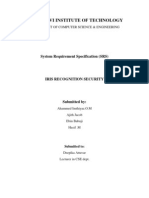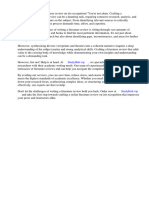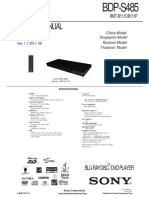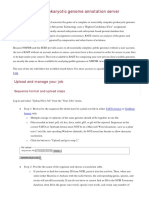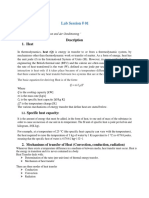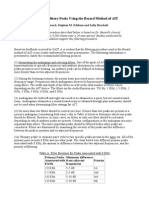Professional Documents
Culture Documents
The Making of Object Recognition Eyeglasses For The Visually Impaired Using Image AI
The Making of Object Recognition Eyeglasses For The Visually Impaired Using Image AI
Original Title
Copyright
Available Formats
Share this document
Did you find this document useful?
Is this content inappropriate?
Report this DocumentCopyright:
Available Formats
The Making of Object Recognition Eyeglasses For The Visually Impaired Using Image AI
The Making of Object Recognition Eyeglasses For The Visually Impaired Using Image AI
Copyright:
Available Formats
Volume 9, Issue 4, April – 2024 International Journal of Innovative Science and Research Technology
ISSN No:-2456-2165 https://doi.org/10.38124/ijisrt/IJISRT24APR624
The Making of Object Recognition Eyeglasses for the
Visually Impaired using Image AI
Dr. Julie Ann B. Real1; Kal-el Gabriel C. Ceradoy2; RJ Leandrei J. Fortuna3; Jeileen Roze N. Gallarte4; Kyla Nezel S. Soriano5;
Akirah Faith A. Emperio6 Nicole Margareth I. Carlos7; Dyanna Chrisleen V. Camia8
Philippine School Doha, Doha, Qatar
Abstract:- People with visual impairment may face In order to alleviate the challenges faced by visually
struggles in their daily activities, as these may affect impaired individuals, recent advancements that are
them socially, physically, and psychologically. This study embedded in systems and artificial intelligence need
aims to address this problem by utilizing quantitative development. Thus, devices like smart glasses were
experimental research to come up with Object manufactured by Google Glass, wherein the detection
Recognition Eyeglasses out of ImageAI. This device aims process is transformed by signaling the visually impaired
to assist the visually impaired person by recognizing the through an audio alert or vibration (Mukhiddinov& Cho,
object in front of them and giving an audio output of the 2021). These smart glasses can distinguish objects and
name of the object. Throughout the testing process, the signals when confronted with various difficulties; however,
Object Recognition Eyeglasses showed accuracy in the smart glasses can only detect at proximity determined by
recognizing different objects and their different signal strength. Additionally, a device that also functions as
varieties. It also showed its capability to recognize an assistive device is a guide cane, which works as a
objects from far distances, with a maximum distance of mobility aid to identify objects and employs tapping sounds
45 meters, and its efficiency in delivering a timely for echolocation, similar to the companion cane (Hersh,
recognition and audio output with an average time 2015). In contrast, these guide canes are inaccurate and
interval of 1.61 and 0.63 seconds respectively. Based on unreliable when it comes to navigating and approaching
these results, the Object Recognition Eyeglasses stands dangerous areas, and present certain issues for visually
as an accurate, efficient, and capable assistive device that impaired people. Similarly, another study presented Object
can help visually impaired people in their day-to-day Recognition Glasses with a fusion of Raspberry Pi and Pi
lives. However, this device still needs improvement in camera for intricate facial recognition procedures, including
terms of convenience by using a phone instead and its detection utilizing an ultrasonic sensor, wherein this
modifying it to not require any internet connection. technology significantly enhanced individuals' quality of life
(Dematti et al, 2023). The studies covered various
Keywords:- Object Recognition Eyeglasses, Image AI, prototypes that provided effective and secure assistance in
Visually Impaired, Assistive Device locating unfamiliar objects and improving their mobility.
I. INTRODUCTION The Object Recognition Eyeglasses aims to support
visually impaired individuals in safely locating their
People who have complications in their eyesight surroundings and notifying them of visible objects, allowing
struggle to keep up with uncomplicated tasks that could be them to identify the objects they will encounter, preventing
done without assistance, yet due to being visually impaired, accidents such as crossing the street, bumping into objects,
it has become a challenge that people face. The World or getting lost. This device would help visually impaired
Health Organization (2022) reported that there are about a people navigate their surroundings while also giving them a
billion people who suffer from moderate to severe distance sense of independence.
vision impairment or blindness. Vision loss has effects on
the daily lives of a person. Brunes and Heir (2021) stated II. RESEARCH QUESTIONS
that personal experiences with fire or explosion, catastrophic
incidents at work, home, or in leisure time, exposure to The objective of this study is to create Object
harmful substances, sexual assaults, war-related events, life- Recognition Eyeglasses for the Visually Impaired out of
threatening diseases or injuries, and severe human suffering ImageAI. Specifically, it answers the following questions:
all showed significant disparities. Visual impairment has
caused individuals to be prone to various challenges every How accurate is the Object Recognition Eyeglasses in
day, such as simply crossing the street, roaming around, or recognizing different objects?;
enjoying their time, as they lack the reaction time and ability What is the maximum distance the Object Recognition
to recognize approaching dangerous situations. Visually Eyeglasses can recognize an object in meters?;
impaired individuals require more assistance, which can How long is the time interval of the Object Recognition
cause issues in circumstances where one does not want to Eyeglasses between seeing the object and recognizing
feel overly dependent on the other. the object in seconds? and;
IJISRT24APR624 www.ijisrt.com 1012
Volume 9, Issue 4, April – 2024 International Journal of Innovative Science and Research Technology
ISSN No:-2456-2165 https://doi.org/10.38124/ijisrt/IJISRT24APR624
How long is the time interval of the Object Recognition Below is the Testing Procedure to Measure the Time
Eyeglasses between recognizing the object and playing Interval of the Object Recognition Eyeglasses between
the sound of the name of the object? Seeing the Object and Recognizing the Object
III. METHODOLOGY Prepare the object to be recognized and a stopwatch.
Set-up the stage by placing a white paper that will serve
This study used experimental research design to create as the background for each object.
Object Recognition Eyeglasses utilizing ImageAI. In order Place the object in front of you.
to achieve the intended results, one or more independent Cover the camera with a piece of paper.
variables are subject to manipulation of additional Turn on and activate the Object Recognition Eyeglasses.
independent variables through the use of the experimental Uncover the camera and immediately start the
research design, a scientific study technique and a scientific stopwatch.
study method (Zubair, 2023). The dependent variable in this Stop the stopwatch once the object has been recognized.
study is the Object Recognition Eyeglasses, while the Do the same for trials 2 and 3.
independent variable is ImageAI. To provide reliable results
and conclusions, this study employed a quantitative Below is the Testing Procedure to Measure the Time
approach, measuring and defining variables (Apuke, 2017).
Interval of the Object Recognition Eyeglasses between
It is crucial to collect data using the quantitative technique
Recognizing the Object and Playing the Sound of the
to comprehend and describe the phenomena under study. Name of the Object
A. Research Locale
Prepare the object to be recognized and a stopwatch.
The research study was conducted and tested at the
Set-up the stage by placing a white paper that will serve
school of the researchers in Qatar. The required facilities are
as the background for each object.
present in the school that enabled them to make the Object
Recognition Eyeglasses. Place the object in front of you.
Cover the camera with a piece of paper.
B. Data Gathering Procedure Turn on and activate the Object Recognition Eyeglasses.
Uncover the camera.
Below is the Testing Procedure to Measure the Accuracy Start the stopwatch once the object has been recognized.
of the Object Recognition Eyeglasses Stop the stopwatch once the program has played the
sound of the name of the object.
Prepare 5 samples of 5 different objects. Do the same for trials 2 and 3.
Position yourself in front of one of the samples.
Set-up the stage by placing a white paper that will serve
as the background for each object.
Turn on and activate the Object Recognition Eyeglasses.
Place the object in front of you.
Wait till the Object Recognition Eyeglasses is able to
recognize the object.
Note down if the Object Recognition Eyeglasses was
able to recognize the object.
Do the same for all samples of each type of object.
Below is the Testing Procedure to Measure the
Maximum Distance the Object Recognition Eyeglasses
can Recognize an Object
Prepare the object to be recognized. and a tape measure.
Position yourself in a large area.
With the tape measure, measure 10 meters from you to
the object to be recognized.
Turn on and activate the Object Recognition Eyeglasses.
Wait till the Object Recognition Eyeglasses is able to
recognize the object.
Note down if the Object Recognition Eyeglasses was
able to recognize the object.
Do the same with distances of 20m, 30m, 40m, 45m, and
50m.
IJISRT24APR624 www.ijisrt.com 1013
Volume 9, Issue 4, April – 2024 International Journal of Innovative Science and Research Technology
ISSN No:-2456-2165 https://doi.org/10.38124/ijisrt/IJISRT24APR624
IV. RESULTS
The section shows the results and interpretation of data that were collected from assembling and testing the device.
A. The Accuracy of the Object Recognition Eyeglasses in Recognizing Different Objects
Table 1: The Accuracy of the Object Recognition Eyeglasses
Trial Object to be Recognized 5 Samples of the Object to be Recognized Success Rate in %
S1: Tall Plastic Bottle
S 2: Small Plastic Bottle
1st Bottle S3: Blue Water Tumbler 100%
S4: Glass Bottle
S5: Large Red Tumbler
S1: Large White Pot
S2: Small White Pot
2nd Potted Plant S3: Regular Sized White Pot 100%
S4: Small Green Pot
S5: Small Glass Pot
The accuracy of the Object Recognition Eyeglasses B. The Maximum Distance of Recognition of the Object
was tested using different samples of different objects and Recognition Eyeglasses:
testing whether it can identify each sample.
Table 2: The Maximum Distance of Recognition
The data on Table 1 displayed the percentage of Distance Recognition
accuracy of the Object Recognition Eyeglasses in 10 meters Yes
identifying the various objects in the vicinity. Each trial has 20 meters Yes
five distinct samples of varying shapes and sorts to 30 meters Yes
determine its correctness with a “YES” response expected in 40 meters Yes
each case. A bottle in the shape of a short plastic bottle, a 45 meters Yes
glass bottle, a flask bottle, or a plastic tumbler is the first 50 meters No
example item. A potted plant with varying components
served as the second example object. Three various types of The researchers tested the maximum distance the
cups—a glass cup, a paper cup, and a mug—were included Object Recognition Eyeglasses can recognize an object by
in the third example item. Bicycles of various sizes and sorts using the same object, in this case, the researchers used a
make up the fourth example object. The last example item person, and tested whether it can recognize the person at a
used to evaluate the assistive device's accuracy was a set of continuously farther distance.
colorful keyboards. With a high success rate of ”YES”, the
Object Recognition Eyeglasses identified all five sample Table 2 displays the greatest distance that the Object
objects—bottles, cups, potted plants, bicycles, and Recognition Eyeglasses can recognize an object in meters.
keyboards—in all of their different shapes and varieties. The recognition range was tested at six different distances to
ensure accuracy. The distances in the list were accurately
Furthermore, related research employed Tensorflow or computed using a measuring tape as a reference. The AI
Python Open pre-training to effectively identify objects correctly identified the person in front of the camera at a
using a camera. The smart glasses improved performance in distance of 10 meters and said "Person." The following
identifying the item in front by 50–60% (Shakkir, 2022). distances apply as well: 20, 30, 40, and 45 meters. After
The equipment works well and can enable those who are testing the AI, the results showed that it could reliably
blind or visually impaired to walk and navigate on their distinguish the person standing in front of the camera at
own. Another comparable gadget was made to alert the user. distances ranging from 10m to 45m. At 50m, the AI was
Users of augmented reality smart glasses can have a more unable to identify the person since they were too far away
remarkable immersive experience thanks to the display or from the camera.
projection system's usage of sensors to track things in view
(Koutromanos&Kazakou, 2023). The ABGs' use of sensors In a similar investigation, accurate photographs were
lowers the challenges that people who are visually impaired taken at a distance estimated to be between 40 and 150
have when doing everyday tasks. meters using an ultrasonic sensor, which generates
ultrasonic waves and detects their reflections (AlSaid et al.,
s=sample 2019). In a similar vein, a study conducted to determine
distance for visually impaired people utilizing object
detection used an HQ image camera with a LIDAR sensor to
provide high-precision distance measurements with accurate
object recognition (Dragne, 2022). Both experiments
IJISRT24APR624 www.ijisrt.com 1014
Volume 9, Issue 4, April – 2024 International Journal of Innovative Science and Research Technology
ISSN No:-2456-2165 https://doi.org/10.38124/ijisrt/IJISRT24APR624
demonstrated that the assistive device is efficient and C. The Time Interval of the Object Recognition Eyeglasses
effective. between Seeing an Object and Recognizing it
The time interval of the Object Recognition Eyeglasses
was tested between seeing an object and recognizing it by
using a stopwatch to measure the time it takes from the
moment the Object Recognition Eyeglasses sees the object
until the program is able to recognize the object.
Table 3: Time interval of the Object Recognition Eyeglasses between seeing an object and recognizing it
Trial 1 2 3 Average
Time interval 1.83 seconds 1.58 seconds 1.41 seconds 1.61 seconds
(in seconds)
Table 3 presents the three different trials done from recognition eyewear discovered that the system could
seeing to recognizing the object by the Object Recognition identify objects and barriers and warn visually impaired
Eyeglasses by using a stopwatch. The average was people of impending dangers (Kumar et al., 2019). In a
computed by adding all the results and dividing the sum by related investigation, the performance of the glasses was
the number of trials. Testing with a pair of scissors, the first evaluated in terms of recognition time using two metrics that
trial succeeded in seeing and recognizing it with a delay of demonstrate improving techniques that lead to an
1.83 seconds. In the second trial, the camera succeeded; It improvement in accuracy and time. Elnabawy et al., 2022).
saw and recognized it with a delay of 1.58 seconds. In the
third trial, the camera succeeded; It saw and recognized it D. The Time Interval of the Object Recognition Eyeglasses
with a delay of 1.41 seconds. between Recognizing the Object and Playing the Sound
of its Name
According to the results, it took the AI, on average, The time interval of the Object Recognition Eyeglasses
1.61 seconds to correctly recognize and identify the name of was tested between recognizing an object to playing the
the object that was given. The three trials demonstrate that sound of its name by using a stopwatch to measure the time
there is a time-dependent lag in seeing and identifying the it takes from the moment the Object Recognition Eyeglasses
provided object because the AI frequently detects additional recognizes the object until the program is able to play the
objects behind the object that the camera has captured. sound of its name.
Another research that used a Raspberry Pi to create object
Table 4: Time Interval of the Object Recognition Eyeglasses between Recognizing an Object and Playing the Sound of its Name
Trial 1 2 3 Average
Time interval 0.66 seconds 0.68 seconds 0.56 seconds 0.63 seconds
(in seconds)
Table 4 depicts the three trials for determining the time The following is the summary of results for each
interval between recognizing and playing the object's sound Statement of the Problem of this study.
using a stopwatch. Three trials were undertaken to
determine the data's credibility, and the average was Accuracy of the Object Recognition Glasses in
computed by dividing the sum of all values by three. In the Identifying Objects
first trial, the audio played for an average of 0.66 seconds.
In the second trial, the audio played for an average of 0.68 Five sample objects of varying types and forms were
seconds. And lastly the third trial, the audio played in an tested, the glasses accurately identified the objects,
average of 0.56 seconds. which resulted in all of the samples being marked as
“YES” and a high percentage of success rate.
According to the data, the Object Recognition
Eyeglasses took an average of 0.63 seconds to play the Maximum Distance the Object Recognition Glasses can
audio after detecting an object. The tests revealed that the Recognize an Object in Meters
audio of the Object Recognition Eyeglasses had the smallest
latency in playing the sound. To guide the vision impaired, The glasses were tested at six distinct distances.
the ImageAIactivates audio and plays it after identifying an Beginning at 10 meters, reaching the maximum distance
object to avoid accidents. The glasses have been shown to at 45 meters, and by 50 meters, it could no longer detect
translate visuals into audio in 3 seconds. Similarly, many the particular object.
smart glasses systems have Artificial Intelligence that
incorporates audio feedback to deliver real-time solutions in
navigating, such as a similar program with the use of eSpeak
was integrated into the Object Recognition Eyeglasses,
wherein the convenience of the audio's speed helps the
visually impaired locate objects faster (Islam et al., 2023).
IJISRT24APR624 www.ijisrt.com 1015
Volume 9, Issue 4, April – 2024 International Journal of Innovative Science and Research Technology
ISSN No:-2456-2165 https://doi.org/10.38124/ijisrt/IJISRT24APR624
Time Interval of the Object Recognition Glasses between Object Recognition Eyeglasses make people aware of
Seeing an Object and Recognizing it the struggles of the visually impaired encounter. Visually
impaired people will have an enhanced and safe lifestyle
The glasses were tested in three trials to determine the while doing simple tasks, wherein their quality of life
time interval between seeing and recognizing the object will be improved and at the same time ensure their
using a stopwatch. On Trials 1, 2, and 3, the glasses wellness.
recognized the sample object with a delay of 1.83 Moreover, future researchers may use this study to assist
seconds, 1.58 seconds, and 1.41 seconds, respectively. in developing a project with similar components. Future
researchers may include more detectors and speed in
The Time Interval of the Object Recognition Glasses playing the audio. The assistive devices should expand
between Recognizing the Object and Playing the Sound the distance to locate other present objects. The research
of its Name suggests using a phone instead of a laptop in
programming the software to make it more convenient.
The voice-activated Object Recognition Glasses The research also suggests making the device eliminate
produced a fast rate of playing audio with a fastest time the Wi-Fi connection. The ability to focus on the given
of 0.56 seconds with a minimum delay of 0.63 seconds object instead of recognizing other objects at once can
in recognizing the object to play the name of the object also be further tested. Future researches are also
presented. suggested to improve the number of objects that can be
recognized due to only recognizing 50 different types of
V. CONCLUSIONS objects.
Through the Findings, the Researchers were Led to REFERENCES
Make the Following Conclusions:
[1]. AlSaid, H., AlKhatib, L., AlOraidh, A., AlHaidar, S.
Following the results, the Object Recognition Eyeglasses & Bashar A. (2019). Deep Learning Assisted Smart
can recognize different objects effectively and Glasses as Educational Aid for Visually Challenged
proficiently as the data showed on the sample objects Students. 2019 2nd International Conference on New
that are close to the prototypes found on the website with Trends in Computing Sciences (ICTCS), 1-6.
a high percentage of success rates. Object Recognition https://doi.org/10.1109/ICTCS.2019.8923044
Eyeglasses were able to operate with a camera that [2]. Apuke, O. (2017). Quantitative research methods : A
functions and results in a clear and accurate synopsis approach. Kuwait Chapter of Arabian
representation of objects. However, the assistive device Journal of Business and Management Review, 6(11),
can only recognize objects at 45 meters whereas by 50 40–47. https://doi.org/10.12816/0040336
meters it can no longer identify objects. To increase the [3]. Brunes, A., & Heir, T. (2021). Serious life events in
safety of the visually impaired the Eyeglasses displayed people with visual impairment versus the general
timely and quick results with an average minimum delay population. International Journal of Environmental
of 1.61 seconds in recognizing the objects present. Research and Public Health, 18(21), 11536.
Lastly, the assistive device displayed a fast rate upon https://doi.org/10.3390/ijerph18211153
recognizing an object to announce the object name, [4]. Dematti, G., Vijaykumar, R., Teggi, A., Naik, L.,
obtaining an average minimum delay of 0.63 seconds. &Guddadamani, D. (2023). Smart Glasses for
This study can help the community in adhering to the Visually Impaired Persons. 4(12).
mission of the school when it comes to being Pro- https://ijrpr.com/uploads/V4ISSUE12/IJRPR20447.p
Environment. In addition, the students and school staff df
are advised to use higher-grade material to increase [5]. Dragne, C., Todirite, I., Iliescu. M., &Pandelea, M.
results of longevity, detection time, and response time (2022). Distance Assessment by Object Detection—
and further investigate to improve the performance of the For Visually Impaired Assistive Mechatronic
Object Recognition Eyeglasses. System. 12(13). https://doi.org/10.3390/app12136342
The Qatar and Philippine communities are encouraged to [6]. Elnabaway, R., Abdennadher, S., Hellwich, O.,
use similar materials available to make cost-effective &Eldawlatly, S. (2022). Object recognition and
Object Recognition Eyeglasses using ImageAI, which localization enhancement in visual prostheses: a real-
has many helpful functions such as identifying obstacles. time mixed reality simulation. 21(91).
The use of audio-operated glasses to efficiently play the https://doi.org/10.1186/s12938-022-01059-7
sound of the object which is convenient is different case [7]. Hersh, M. (2015). Cane use and late onset visual
scenarios. The researchers advise the communities to impairment. Technology and Disability, 27(3), 103–
find other materials to improve the program's capabilities 116. https://doi.org/10.3233/TAD-150432
and features. Due to the struggles of the visually [8]. Islam, R., Akter, S., Iqbal, F., Rahman, S., & Khan,
impaired in navigating their daily lifestyle, they are more R. (2022). Deep learning-based object detection and
prone to be in threatening situations. surrounding environment description for visually
impaired people. 9(6).
https://doi.org/10.1016/j.heliyon.2023.e16924
IJISRT24APR624 www.ijisrt.com 1016
Volume 9, Issue 4, April – 2024 International Journal of Innovative Science and Research Technology
ISSN No:-2456-2165 https://doi.org/10.38124/ijisrt/IJISRT24APR624
[9]. Koutromanos, G., &Kazakou, G. (2023). Augmented
reality smart glasses use and acceptance: Α literature
review. 2. https://doi.org/10.1016/j.cexr.2023.10002
[10]. Kumar, S., Varun, K., & Rahman, J. (2019). Object
Recognition using perspective glass for the
blind/visually impaired. 4(1).
http://doi.org/10.5281/zenodo.2624630
[11]. Mukhiddinov, M. & Cho, J. (2021). Smart Glasses
System Using Deep Learning for the Blind and
Visually Impaired. 10(22), 2756.
https://doi.org/10.3390/electronics10222756
[12]. Shakkir, M., Shaji, B., Muhsin, M., Aprem, B., &
Abhiraj, K. (2022). Virtual Smart Glass for Blind
using Object Detection. 10(10).
https://www.ijres.org/papers/Volume-10/Issue-
10/1010537544.pdf
[13]. World Health Organization (2022). Blindness and
vision impairment. https://www.who.int/news-
room/fact-sheets/detail/blindness-and-visual-
impairment
[14]. Zubair, A. (2023). Experimental Research Design-
types & process. Academia Open.
IJISRT24APR624 www.ijisrt.com 1017
You might also like
- 3K4K 4th Gen Mech TipsDocument128 pages3K4K 4th Gen Mech Tipsrusselguthrie_39831586% (7)
- Ritz-Carlton Golden StandardDocument2 pagesRitz-Carlton Golden StandardElgin Renz Timbreza Rocili0% (1)
- Lesson 1 - CLEAN AND MAINTAIN KITCHEN TOOLS, AND, PREMISESDocument162 pagesLesson 1 - CLEAN AND MAINTAIN KITCHEN TOOLS, AND, PREMISESAdriano Bahian Jr.100% (7)
- Storm Boy Program - Year 3Document8 pagesStorm Boy Program - Year 3glen100% (1)
- 214 - Water Flow SensorDocument29 pages214 - Water Flow SensorSingam SridharNo ratings yet
- Object Detection and Recognition System (Using TensorFlow)Document8 pagesObject Detection and Recognition System (Using TensorFlow)FilsonNo ratings yet
- Writing Rough Draft of Research PaperDocument1 pageWriting Rough Draft of Research PaperRaja AdilNo ratings yet
- Exam Paper For Edxcel iGCSE Language Pater BDocument28 pagesExam Paper For Edxcel iGCSE Language Pater BDamask RoseNo ratings yet
- Real-Time Object Detection Using Deep LearningDocument4 pagesReal-Time Object Detection Using Deep LearningIJRASETPublicationsNo ratings yet
- Facial Recognition Smart Glasses For Visually Challenged PersonsDocument5 pagesFacial Recognition Smart Glasses For Visually Challenged PersonsABD BESTNo ratings yet
- Synthesis of The Study 3Document10 pagesSynthesis of The Study 3Kyran LisacaNo ratings yet
- Virtual Eye For Blind People Using Deep LearningDocument8 pagesVirtual Eye For Blind People Using Deep LearningIJRASETPublicationsNo ratings yet
- ReportDocument32 pagesReport43FYCM II Sujal NeveNo ratings yet
- IJRPR13518Document4 pagesIJRPR13518Monalia ghoshNo ratings yet
- Eye Tracking in Cognitive Psychology ResearchDocument15 pagesEye Tracking in Cognitive Psychology ResearchDeepali NayakNo ratings yet
- A Google Glass Based Real-Time Scene Analysis For The Visually ImpairedDocument19 pagesA Google Glass Based Real-Time Scene Analysis For The Visually ImpairedRohini HGNo ratings yet
- 5658 PhatDocument21 pages5658 PhatRajanikanth AluvaluNo ratings yet
- Identification of Children Using HOGDocument10 pagesIdentification of Children Using HOGIJRASETPublicationsNo ratings yet
- Bionic EyeDocument4 pagesBionic Eyekatikala binduNo ratings yet
- IJEERPaper 29Document8 pagesIJEERPaper 29Atharva KarvalNo ratings yet
- Comparison Study of Funduscopic Examination Using A Smartphone-Based Digital Ophthalmoscope and The Direct OphthalmoscopeDocument6 pagesComparison Study of Funduscopic Examination Using A Smartphone-Based Digital Ophthalmoscope and The Direct OphthalmoscopeWalisson BarbosaNo ratings yet
- Blind Assistance System Using Image ProcessingDocument11 pagesBlind Assistance System Using Image ProcessingIJRASETPublicationsNo ratings yet
- BioniceyeDocument4 pagesBioniceyePrince ShankarNo ratings yet
- Blinds Personal Assistant Application For AndroidDocument7 pagesBlinds Personal Assistant Application For AndroidIJRASETPublicationsNo ratings yet
- Blind Person Assistant Object DetectionDocument7 pagesBlind Person Assistant Object DetectionIJRASETPublicationsNo ratings yet
- Social Distance Detection With The Help of Deep LearningDocument7 pagesSocial Distance Detection With The Help of Deep LearningIJRASETPublicationsNo ratings yet
- Smart System For The BlindDocument4 pagesSmart System For The BlindInternational Journal of Innovative Science and Research TechnologyNo ratings yet
- Pupil Dynamics For Iris Liveness Detection: Adam Czajka, Senior Member, IEEEDocument10 pagesPupil Dynamics For Iris Liveness Detection: Adam Czajka, Senior Member, IEEEJagannath JagguNo ratings yet
- Vision Assistance System Using Object Detection and Artificial IntelligenceDocument7 pagesVision Assistance System Using Object Detection and Artificial IntelligenceInternational Journal of Innovative Science and Research TechnologyNo ratings yet
- Bionic Eye Research PaperDocument4 pagesBionic Eye Research Paperfysfs7g3100% (1)
- Set Conference 22mdt1034Document17 pagesSet Conference 22mdt1034vikramkarthick2001No ratings yet
- Object Detection System With Voice Alert For BlindDocument7 pagesObject Detection System With Voice Alert For BlindIJRASETPublicationsNo ratings yet
- StudyofeyeTraking IEEEDocument7 pagesStudyofeyeTraking IEEETimsonNo ratings yet
- Ai Glass 1Document6 pagesAi Glass 1Magar AnzelNo ratings yet
- Detecting Eye Contact Using Wearable Eye-Tracking GlassesDocument6 pagesDetecting Eye Contact Using Wearable Eye-Tracking GlassesMesfin GudetaNo ratings yet
- FarooqDocument20 pagesFarooqKyleNo ratings yet
- A Smart Wearable Guiding Device For The Visually Impaired PeopleDocument7 pagesA Smart Wearable Guiding Device For The Visually Impaired PeopleIJRASETPublicationsNo ratings yet
- Aralikatti 2020 J. Phys. Conf. Ser. 1706 012149Document13 pagesAralikatti 2020 J. Phys. Conf. Ser. 1706 012149Viney ChhillarNo ratings yet
- A Google Glass Based Real-Time Scene Analysis ForDocument20 pagesA Google Glass Based Real-Time Scene Analysis ForPunya GowdaNo ratings yet
- Real Time Obj Detect For BlindDocument6 pagesReal Time Obj Detect For Blinddata proNo ratings yet
- Tobii Customer Case Cardiff University 03092010 WebDocument2 pagesTobii Customer Case Cardiff University 03092010 WebJon WardNo ratings yet
- 19bce0950 VL2020210503924 Pe003Document18 pages19bce0950 VL2020210503924 Pe003Priyanshu WalechaNo ratings yet
- Chapter 1 5Document102 pagesChapter 1 5Darcy Halili100% (1)
- (IJIT-V6I3P2) : Sheba Jebakani, Divya J, Megha S M, Santhosh H VDocument7 pages(IJIT-V6I3P2) : Sheba Jebakani, Divya J, Megha S M, Santhosh H VIJITJournalsNo ratings yet
- Eye Tracking Article - Found Own - Peer ReviewedDocument34 pagesEye Tracking Article - Found Own - Peer ReviewedalexisterblancheNo ratings yet
- A Google Glass Based Real-Time Scene Analysis For The Visually ImpairedDocument19 pagesA Google Glass Based Real-Time Scene Analysis For The Visually ImpairedN.Yathish rajNo ratings yet
- Paulo S Research Proposal CopyDocument5 pagesPaulo S Research Proposal CopyVinicius SedrimNo ratings yet
- Iris Recognition PHD ThesisDocument7 pagesIris Recognition PHD Thesisgbwy79ja100% (1)
- Analysis of Mask Wearability Via Feature Based & Image Based Approach Using Image Processing-IJRASETDocument12 pagesAnalysis of Mask Wearability Via Feature Based & Image Based Approach Using Image Processing-IJRASETIJRASETPublicationsNo ratings yet
- Result - 9 - 19 - 2023, 7 - 14 - 17 AMDocument43 pagesResult - 9 - 19 - 2023, 7 - 14 - 17 AMagbaipissNo ratings yet
- The Discrete Wavelet Transform Based Iris Recognition For Eyes With Non-Cosmetic Contact LensDocument10 pagesThe Discrete Wavelet Transform Based Iris Recognition For Eyes With Non-Cosmetic Contact LensIAES IJAINo ratings yet
- Smartsun Introduction - Group 3Document2 pagesSmartsun Introduction - Group 3rainjoshuaa09No ratings yet
- S R SDocument7 pagesS R Sfaizan_keNo ratings yet
- An Enhanced Iris Recognition and Authentication System Using Energy MeasureDocument7 pagesAn Enhanced Iris Recognition and Authentication System Using Energy MeasureNomula SowmyareddyNo ratings yet
- Implementation Paper - Eye Movement Recognition Based Human Machine Interaction SystemDocument7 pagesImplementation Paper - Eye Movement Recognition Based Human Machine Interaction SystemIJRASETPublicationsNo ratings yet
- Vision AI A Deep Learning-Based Object Recognition System For Visually Impaired People Using TensorFlow and OpenCVDocument7 pagesVision AI A Deep Learning-Based Object Recognition System For Visually Impaired People Using TensorFlow and OpenCVIJRASETPublicationsNo ratings yet
- UntitledDocument25 pagesUntitledkabir omotayoNo ratings yet
- Personal Authentication Based On IRIS Recognition: Mayank M Badgandi, K Srinivas RaoDocument4 pagesPersonal Authentication Based On IRIS Recognition: Mayank M Badgandi, K Srinivas RaoerpublicationNo ratings yet
- A Mobile Application For The Stereoacuity TestDocument12 pagesA Mobile Application For The Stereoacuity TestMiguel Angel Palacios BlazquezNo ratings yet
- Literature Review of Iris RecognitionDocument5 pagesLiterature Review of Iris Recognitionafmzhfbyasyofd100% (1)
- Proj Symposium Paper FormatDocument6 pagesProj Symposium Paper FormatMohammed KaisNo ratings yet
- Potential Eye Tracking Metrics and Indicators To Measure Cognitive Load inDocument9 pagesPotential Eye Tracking Metrics and Indicators To Measure Cognitive Load inTaisir AlhiloNo ratings yet
- An Intelligent Alarm Based Visual Eye Tracking Algorithm For Cheating Free Examination SystemDocument7 pagesAn Intelligent Alarm Based Visual Eye Tracking Algorithm For Cheating Free Examination SystemVazeema SiddiquiNo ratings yet
- TSP CMC 28540Document23 pagesTSP CMC 28540Cesia E RiveraNo ratings yet
- Pdi Report (Copy)Document25 pagesPdi Report (Copy)Susmitha ReddyNo ratings yet
- Real Time Face Mask DetectorUsing Machine LearningDocument4 pagesReal Time Face Mask DetectorUsing Machine LearningInternational Journal of Innovative Science and Research TechnologyNo ratings yet
- Assessment of Integrated Poultry Manure and Synthetic Fertilizer Effects on Maize (Zea mays) Growth and Soil Properties: A Study from Bayero University, KanoDocument15 pagesAssessment of Integrated Poultry Manure and Synthetic Fertilizer Effects on Maize (Zea mays) Growth and Soil Properties: A Study from Bayero University, KanoInternational Journal of Innovative Science and Research Technology100% (1)
- Seasonal Variation and Distribution Patterns of Endophytic Community in Withania SomniferaDocument7 pagesSeasonal Variation and Distribution Patterns of Endophytic Community in Withania SomniferaInternational Journal of Innovative Science and Research TechnologyNo ratings yet
- Utilizing Chicken Eggshells and Waste Glass Powder as Cement Fillers for Environmental StabilityDocument6 pagesUtilizing Chicken Eggshells and Waste Glass Powder as Cement Fillers for Environmental StabilityInternational Journal of Innovative Science and Research TechnologyNo ratings yet
- Personal Capabilities of The Non-Teaching Personnel and Client SatisfactionDocument8 pagesPersonal Capabilities of The Non-Teaching Personnel and Client SatisfactionInternational Journal of Innovative Science and Research TechnologyNo ratings yet
- Transforming Challenges to Victories: An Inquiry on Transformational Leadership of School Leaders in the Public Elementary SchoolsDocument54 pagesTransforming Challenges to Victories: An Inquiry on Transformational Leadership of School Leaders in the Public Elementary SchoolsInternational Journal of Innovative Science and Research TechnologyNo ratings yet
- The Influence of Continuance Commitment on Job Satisfaction of Barangay Health Workers in Malaybalay City, BukidnonDocument14 pagesThe Influence of Continuance Commitment on Job Satisfaction of Barangay Health Workers in Malaybalay City, BukidnonInternational Journal of Innovative Science and Research TechnologyNo ratings yet
- Intelligent Clinical Documentation: Harnessing Generative AI For Patient-Centric Clinical Note GenerationDocument15 pagesIntelligent Clinical Documentation: Harnessing Generative AI For Patient-Centric Clinical Note GenerationInternational Journal of Innovative Science and Research TechnologyNo ratings yet
- Exploring The Potential Advantages of Traditional Therapies in Autoimmune Blistering Illnesses: A Comprehensive Review and Analysis, ResearchDocument12 pagesExploring The Potential Advantages of Traditional Therapies in Autoimmune Blistering Illnesses: A Comprehensive Review and Analysis, ResearchInternational Journal of Innovative Science and Research TechnologyNo ratings yet
- Meta Land: Redefining Virtual Communities Through Centralized Governance, Inclusivity and InnovationDocument5 pagesMeta Land: Redefining Virtual Communities Through Centralized Governance, Inclusivity and InnovationInternational Journal of Innovative Science and Research TechnologyNo ratings yet
- Solar Based Multilevel Inverter F o R BLDC Motor DriveDocument8 pagesSolar Based Multilevel Inverter F o R BLDC Motor DriveInternational Journal of Innovative Science and Research TechnologyNo ratings yet
- Skin Disease Detection and Remedial SystemDocument7 pagesSkin Disease Detection and Remedial SystemInternational Journal of Innovative Science and Research TechnologyNo ratings yet
- Design and Development of Multi-Featured Medical StretcherDocument4 pagesDesign and Development of Multi-Featured Medical StretcherInternational Journal of Innovative Science and Research TechnologyNo ratings yet
- EmoConnect: Nurturing Trust and Relationship Bonds in Alzheimer's ConversationsDocument3 pagesEmoConnect: Nurturing Trust and Relationship Bonds in Alzheimer's ConversationsInternational Journal of Innovative Science and Research TechnologyNo ratings yet
- Unlocking Sentiments: Enhancing IOCL Petrol Pump ExperiencesDocument8 pagesUnlocking Sentiments: Enhancing IOCL Petrol Pump ExperiencesInternational Journal of Innovative Science and Research TechnologyNo ratings yet
- Smart and Secure Home With ChatbotDocument9 pagesSmart and Secure Home With ChatbotInternational Journal of Innovative Science and Research TechnologyNo ratings yet
- Preparation and Identification of Magnetic Iron Nanoparticle Based On A Natural Hydrogel and Its Performance in Targeted Drug DeliveryDocument17 pagesPreparation and Identification of Magnetic Iron Nanoparticle Based On A Natural Hydrogel and Its Performance in Targeted Drug DeliveryInternational Journal of Innovative Science and Research TechnologyNo ratings yet
- Development of Smart Ground Fault Location Model For Radial Distribution SystemDocument14 pagesDevelopment of Smart Ground Fault Location Model For Radial Distribution SystemInternational Journal of Innovative Science and Research TechnologyNo ratings yet
- Fall Detection and Boundary Detection in Care HomesDocument7 pagesFall Detection and Boundary Detection in Care HomesInternational Journal of Innovative Science and Research TechnologyNo ratings yet
- Application of Plant Growth Promoting Rhizobacteria On Vegetative Growth in Chili Plants (Capsicum Frutescens L.)Document7 pagesApplication of Plant Growth Promoting Rhizobacteria On Vegetative Growth in Chili Plants (Capsicum Frutescens L.)International Journal of Innovative Science and Research TechnologyNo ratings yet
- Exploring The Post-Annealing Influence On Stannous Oxide Thin Films Via Chemical Bath Deposition Technique: Unveiling Structural, Optical, and Electrical DynamicsDocument7 pagesExploring The Post-Annealing Influence On Stannous Oxide Thin Films Via Chemical Bath Deposition Technique: Unveiling Structural, Optical, and Electrical DynamicsInternational Journal of Innovative Science and Research TechnologyNo ratings yet
- Reading Intervention Through "Brigada Sa Pagbasa": Viewpoint of Primary Grade TeachersDocument3 pagesReading Intervention Through "Brigada Sa Pagbasa": Viewpoint of Primary Grade TeachersInternational Journal of Innovative Science and Research TechnologyNo ratings yet
- Firm Size As A Mediator Between Inventory Management Andperformance of Nigerian CompaniesDocument8 pagesFirm Size As A Mediator Between Inventory Management Andperformance of Nigerian CompaniesInternational Journal of Innovative Science and Research TechnologyNo ratings yet
- Application of Game Theory in Solving Urban Water Challenges in Ibadan-North Local Government Area, Oyo State, NigeriaDocument9 pagesApplication of Game Theory in Solving Urban Water Challenges in Ibadan-North Local Government Area, Oyo State, NigeriaInternational Journal of Innovative Science and Research TechnologyNo ratings yet
- Global Warming Reduction Proposal AssessmentDocument6 pagesGlobal Warming Reduction Proposal AssessmentInternational Journal of Innovative Science and Research TechnologyNo ratings yet
- On The Development of A Threat Driven Model For Campus NetworkDocument14 pagesOn The Development of A Threat Driven Model For Campus NetworkInternational Journal of Innovative Science and Research TechnologyNo ratings yet
- Detection of Phishing WebsitesDocument6 pagesDetection of Phishing WebsitesInternational Journal of Innovative Science and Research TechnologyNo ratings yet
- A Study To Assess The Knowledge Regarding Teratogens Among The Husbands of Antenatal Mother Visiting Obstetrics and Gynecology OPD of Sharda Hospital, Greater Noida, UpDocument5 pagesA Study To Assess The Knowledge Regarding Teratogens Among The Husbands of Antenatal Mother Visiting Obstetrics and Gynecology OPD of Sharda Hospital, Greater Noida, UpInternational Journal of Innovative Science and Research TechnologyNo ratings yet
- PHREEQ C Modelling Tool Application To Determine The Effect of Anions On Speciation of Selected Metals in Water Systems Within Kajiado North Constituency in KenyaDocument71 pagesPHREEQ C Modelling Tool Application To Determine The Effect of Anions On Speciation of Selected Metals in Water Systems Within Kajiado North Constituency in KenyaInternational Journal of Innovative Science and Research TechnologyNo ratings yet
- Mandibular Mass Revealing Vesicular Thyroid Carcinoma A Case ReportDocument5 pagesMandibular Mass Revealing Vesicular Thyroid Carcinoma A Case ReportInternational Journal of Innovative Science and Research TechnologyNo ratings yet
- Esophageal Melanoma - A Rare NeoplasmDocument3 pagesEsophageal Melanoma - A Rare NeoplasmInternational Journal of Innovative Science and Research TechnologyNo ratings yet
- Pfeiffer Work With TurboDocument44 pagesPfeiffer Work With TurbozayerirezaNo ratings yet
- Sony BDP-S485 Ver. 1.1 PDFDocument134 pagesSony BDP-S485 Ver. 1.1 PDFboroda2410No ratings yet
- Audio AnalgesiaDocument7 pagesAudio AnalgesiaRisana RahoofNo ratings yet
- Lesson PlanDocument4 pagesLesson PlanAyyar KandasamyNo ratings yet
- Pages ManualDocument10 pagesPages ManualMandy ZibartNo ratings yet
- An Ecological, Socio-Economic and Silvicultural Assessment of The Sustainability of Reduced Impact Logging in Tropical ForestsDocument15 pagesAn Ecological, Socio-Economic and Silvicultural Assessment of The Sustainability of Reduced Impact Logging in Tropical ForestsSryahwa PublicationsNo ratings yet
- Ejercicios EquilibrioDocument3 pagesEjercicios EquilibrioLorena Mazo TorresNo ratings yet
- Rast TutorialDocument10 pagesRast TutorialPeter JustinNo ratings yet
- EE 2010 Lab Manual Ver2Document17 pagesEE 2010 Lab Manual Ver2Abdulrhman AlshameriNo ratings yet
- 103 108 PDFDocument6 pages103 108 PDFMatiyas ZewdeNo ratings yet
- Lab Report 1Document7 pagesLab Report 1vj kumarNo ratings yet
- 06 951 EVO FINAL WebDocument16 pages06 951 EVO FINAL WebabstraferNo ratings yet
- Expected Puzzle Questions For Ibps Po Mains ExamsDocument35 pagesExpected Puzzle Questions For Ibps Po Mains ExamsKumar UddeshyaNo ratings yet
- Musketeer Prestige Class: Classes: Fighters and Monks From All Over The Land Make For GoodDocument4 pagesMusketeer Prestige Class: Classes: Fighters and Monks From All Over The Land Make For Goodpetri.ruotanen6205No ratings yet
- Arellano-Purposive Communication - Lesson 3Document3 pagesArellano-Purposive Communication - Lesson 3Redilita DalanginNo ratings yet
- 01 Website Jadual Tren 32 ETS 15 Jan 2022 - UpdateDocument2 pages01 Website Jadual Tren 32 ETS 15 Jan 2022 - UpdateWan Yoke NengNo ratings yet
- 1 Modul Bahasa Inggris Kelas 4Document8 pages1 Modul Bahasa Inggris Kelas 4UshuluddinNo ratings yet
- New Microsoft Word DocumentDocument13 pagesNew Microsoft Word DocumentSheikh ShoaibNo ratings yet
- MBM 543 - QB 2017Document2 pagesMBM 543 - QB 2017deepika singhNo ratings yet
- (Data Sheet) EF500 IbioDocument2 pages(Data Sheet) EF500 IbioConstructora de IdeasNo ratings yet
- Apx2 - 2022-1Document3 pagesApx2 - 2022-1Joeme AlvesNo ratings yet
- Shredded in Six Fat Loss AcceleratorDocument35 pagesShredded in Six Fat Loss AcceleratorntnzzmxzkgznblhodtNo ratings yet
- Berard FiltersDocument4 pagesBerard FiltersRafael Diaz GarciaNo ratings yet










